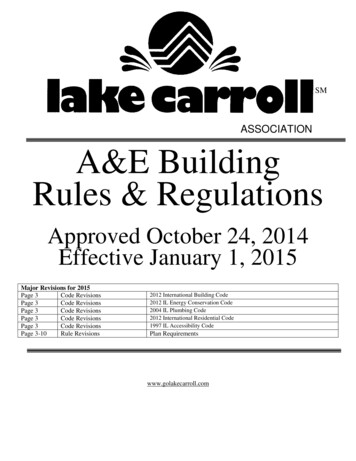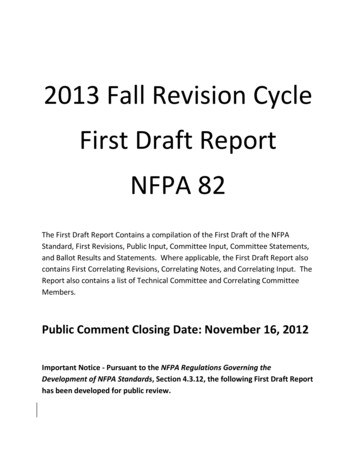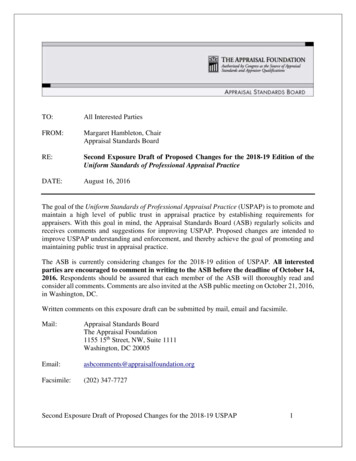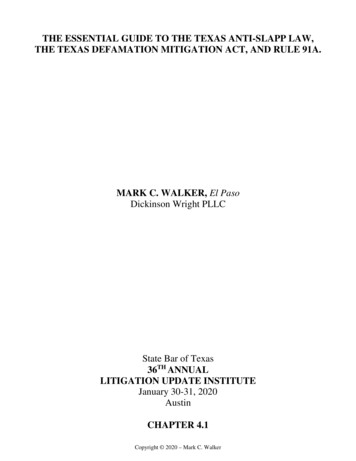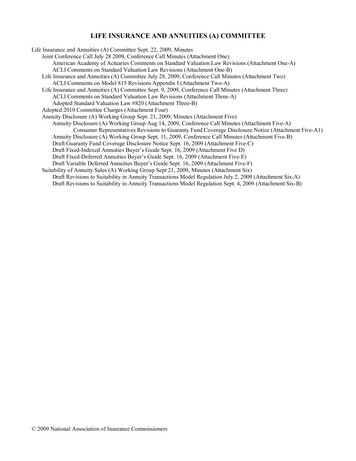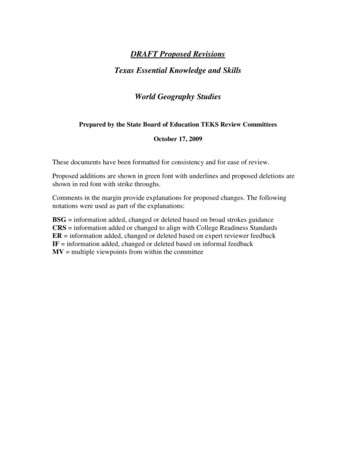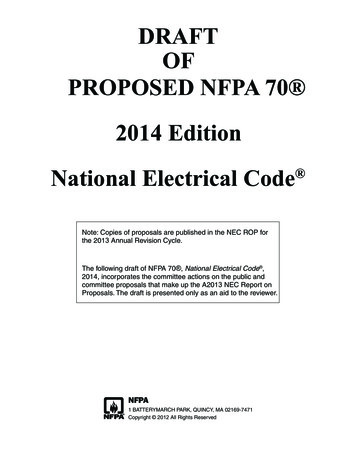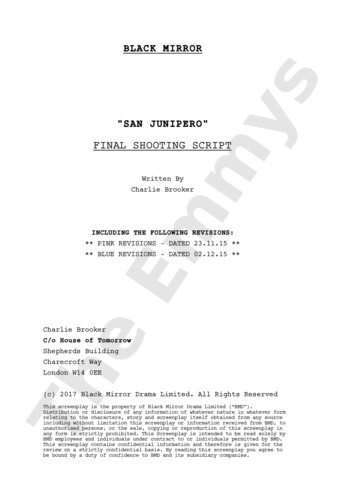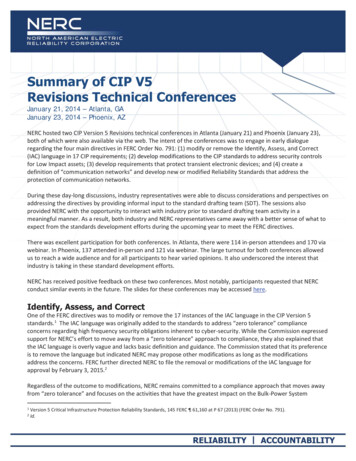
Transcription
DRAFT Proposed RevisionsTexas Essential Knowledge and SkillsCareer and Technical Education (CTE)—Law, Public Safety, Corrections and SecurityPrepared by the State Board of Education TEKS Review CommitteesFirst Draft, August 2014These draft proposed revisions reflect the changes to the career and technical education (CTE) Texas Essential Knowledge and Skills (TEKS) that have been recommendedby State Board of Education-appointed TEKS review committees for courses in the Law, Public Safety, Corrections and Security Career Cluster. Proposed additions areshown in green font with underlines (additions) and proposed deletions are shown in red font with strikethroughs (deletions).Comments in the right-hand column provide explanations for the proposed changes. The following notations were used as part of the explanations:CRS—information added or changed to align with the Texas College and Career Readiness Standards (CCRS)MV—multiple viewpoints from within the committeeVA—information added, changed, or deleted to increase vertical alignmentTABLE OF CONTENTSCommittee 1Committee 2Principles of Law, Public Safety, Corrections andSecurity. .2Law Enforcement I . 31Correctional Services .6Law Enforcement II . 38Federal Law Enforcement and Protective Services .14Forensic Science . 46Firefighter I .20Court Systems and Practices . 55Firefighter II .27Practicum in Law, Public Safety, Corrections andSecurity. . 58
§130.292. Principles of Law, Public Safety, Corrections, and Security (One-Half to One Credit). Committee recommends that coursecredit remain the same so that individual districts statewide may provide credit in the best interest of their students.TEKS with editsGeneral requirements. This course is recommended for students in Grades 9-12.(b)Introduction.(1)CTE General Statement: CTE instruction provides content aligned with challenging academic standardsand relevant technical knowledge and skills for students to further their education and succeed in currentor emerging professions.Career Cluster General Statement: The Law, Public Safety, Corrections & Security Career Clusterfocuses on planning, managing, and providing legal, public safety, protective services and homelandsecurity, including professional and technical support services.Course Information: Principles of Law, Public Safety, Corrections, and Security introduces students toprofessions in law enforcement, protective services, corrections, firefighting, and emergency managementservices. Students will examine the roles and responsibilities of police, courts, corrections, privatesecurity, and protective agencies of fire and emergency services. The course provides students with anoverview of the skills necessary for careers in law enforcement, fire service, protective services, andcorrections.This course is recommended for students in Grades 9-12.(2)(3)(4)Committee CommentsCommittee recommends that course creditremain the same so that individual districtsstatewide may provide credit in the bestinterest of their students.AFT(a)(c)Knowledge and skills.(1)The student demonstrates professional standards/employability skills as required by business andindustry. The student is expected to:(A)The student achieves business and industry employability skills standards such as; attendance, on-timearrival, meeting deadlines, working toward personal/team goals every day, and ethical use of technology.(2)The student achieves academic knowledge and skills required for a career and postsecondary educationopportunities associated with law, public safety, corrections, and security protective services. The studentis expected to:(A)apply English language arts knowledge and skills required for career and postsecondary educationopportunities;DR(5)CTSO Information: Students are encouraged to participate in extended learning experiences such ascareer and technical student organizations and other leadership or extracurricular organizations.Such as and Including Statement: Statements that contain the word "including" reference content thatmust be mastered, while those containing the phrase "such as" are intended as possible illustrativeexamples.Principles of Law, Public Safety, Corrections, and Security2
apply mathematics knowledge and skills required for career and postsecondary education opportunities;and(C)apply science knowledge and skills for career and postsecondary education associated with law, publicsafety, corrections, and protective services.(3)The student uses communication skills in creating, expressing, and interpreting information and ideas,including technical terminology and information. The student is expected to:(A)model effective use of grammar to demonstrate verbal communication skills;(B)execute speaking strategies used to communicate specific ideas to various audiences;(C)interpret voice quality and delivery to interpret verbal communication; and(D)model effective interpersonal skills necessary to communicate with coworkers and the public.(4)The student formulates ideas, proposals, and solutions to address problems related to law, public safety,corrections, and security in order to ensure effective and efficient delivery of services. The student isexpected to:(A)use logical constructions to formulate ideas, proposals, and solutions to problems;(B)formulate ideas, proposals, and solutions to ensure delivery of services; and(C)use critical-thinking skills to solve ethical issues identified in law, public safety, corrections, and security.(5)The student implements measures to maintain safe and healthful working conditions in a law and publicsafety environment. The student is expected to:(A)identify the dangers associated with careers in law, public safety, corrections, and security;(B)recommend strategies for issues related to the safety and health of employees based on an assessment of asimulated workplace environment;(C)discuss methods for safe handling of hazardous materials;(D)discuss the importance of good health and physical fitness; and(E)demonstrate first aid and cardiopulmonary resuscitation procedures.(6)The student analyzes the legal responsibilities associated with roles and functions within law, publicsafety, corrections, and security organizations to demonstrate a commitment to professional and ethicalbehavior. The student is expected to:(A)examine real-world situations involving ethical dilemmas and professional conduct;(B)explain laws, regulations, and policies that govern professionals; and(C)recommend a strategy for responding to an unethical or illegal situation.DRAFT(B)Principles of Law, Public Safety, Corrections, and Security3
The student recognizes the importance of interagency cooperation. The student is expected to:(A)discuss the importance of police, fire, emergency medical services, court, corrections, and securitysystems working together to protect the public;(B)explain the roles and responsibilities of first responders;(C)identify jurisdictional problems that may arise as multiple agencies work together; and(D)differentiate the roles of private security and public law enforcement agencies.(8)The student understands the historical and philosophical development of criminal law. The student isexpected to:(A)identify the sources and origin of law in the United States;(B)explain the impact of the United States Constitution and Bill of Rights on criminal law in regard to therights of citizens;(C)differentiate between crimes classified as felonies or misdemeanors and the punishments for each;(D)analyze the essential elements and classifications of a crime;(E)identify problems commonly associated with the enforcement of criminal laws; and(F)outline the process by which laws are enacted.(9)The student identifies the roles of the public safety professional. The student is expected to:(A)identify career opportunities in federal, state, county, and municipal law enforcement agencies;(B)identify the education and training required for various levels of law enforcement;(C)discuss the history of policing in the United States;(D)identify the roles and responsibilities of law enforcement professionals;(E)analyze the impact of constitutional law on police as it relates to arrest, use of force, searches, andseizure;(F)examine the role of emergency medical services in public safety; and(G)identify how public safety professionals manage the stress related to these jobs.(10)The student identifies the roles and functions of court systems. The student is expected to:(A)identify career opportunities in the court systems;(B)identify the levels and functions of criminal courts;(C)examine the roles of the courtroom work groups such as judges, prosecutors, defense counsel, andbailiffs;DRAFT(7)Principles of Law, Public Safety, Corrections, and Security4
explain pretrial and courtroom procedures; and(E)identify types of sentencing and sentencing rules.(11)The student identifies the roles and functions of the correctional system. The student is expected to:(A)explain career opportunities available in the correctional system, including probation and parole;(B)explain the duties and responsibilities of correctional officers;(C)outline the history of prisons in the United States;(D)explain the differences between jails and prisons;(E)identify the levels of security in prisons and jails; and(F)explain the constitutional rights of inmates in prisons and jails.(12)The student identifies the roles and functions of private security systems and agencies. The student isexpected to:(A)explain the career opportunities available in private security;(B)discuss the history and importance of private security in the United States; and(C)examine the relationship between private security and public safety agencies.(13)The student identifies the roles and functions of fire protection services. The student is expected to:(A)identify the career opportunities in fire protection services;(B)explain the duties and responsibilities of firefighters;(C)recognize the importance of the operation of 911 and computer-aided dispatch systems; and(D)explain the relationship between police, fire, and emergency medical services.(14)The student identifies the roles and functions of student community organizations that support or provideadditional information and guidance to those interested in law, public safety, corrections, and protectiveservices. The student is expected to:Addition to provide the students withgreater insight to student and communityorganizations associated with LPSCS(A)Research and may participate organizations such as: SkillsUSA, Law Enforcement Explorer Scouts,National Technical Honor Society, etc.Addition to provide the students withgreater insight to student and communityorganizations associated with LPSCS(B)Identify community outreach organizations such as: Safe, Citizen on Patrol, Local student PoliceOrganizations, or National student Police organizations.Addition to provide the students withgreater insight to student and communityorganizations associated with LPSCSDRAFT(D)Principles of Law, Public Safety, Corrections, and Security5
§130.297. Correctional Services (One to Two Credits).(a)Committee recommends that course credit remains the same so that individual districtsstatewide may provide credit in the best interest of their studentsTEKS with editsCommittee CommentsGeneral requirements. This course is recommended for students in Grades 11-10 - 12. Recommendedprerequisite: Principles of Law, Public Safety, Corrections, and Security.Introduction. In Correctional Services, students prepare for certification required for employment as amunicipal, county, state or federal correctional officer. The student will learn the role and responsibilitiesof a county or municipal correctional officer; discuss relevant rules, regulations, and laws of municipal,county, state or federal facilities; and discuss defensive tactics, restraint techniques, and first aidprocedures as used in the municipal, county, state or federal correctional setting. The student will analyzerehabilitation and alternatives to institutionalization for inmates.(1)General Statement: CTE instruction provides content aligned with challenging academic standards andrelevant technical knowledge and skills for students to further their education and succeed in current oremerging professions.Career Cluster General Statement: The Law, Public Safety, Corrections & Security Career Clusterfocuses on planning, managing, and providing legal, public safety, protective services and homelandsecurity, including professional and technical support services.Correctional Services, students prepare for certification required for employment as a municipal, county,state or federal correctional officer. The student will learn the role and responsibilities of a county ormunicipal correctional officer; discuss relevant rules, regulations, and laws of municipal, county, state orfederal facilities; and discuss defensive tactics, restraint techniques, and first aid procedures as used in themunicipal, county, state or federal correctional setting. The student will analyze rehabilitation andalternatives to institutionalization for inmates.This course is recommended for students in Grades 10 –12. Recommended prerequisite: Principles ofLaw, Public Safety, Corrections, and Security.Students are encouraged to participate in extended learning experiences such as career and technicalstudent organizations and other leadership or extracurricular organizations.Statements that contain the word "including" reference content that must be mastered, while thosecontaining the phrase "such as" are intended as possible illustrative examples.Knowledge and skills.The student demonstrates professional standards/employability skills as required by business andindustry. The student is expected to:The student achieves business and industry employability skills standards such as, attendance, on-timearrival, meeting deadlines, working toward personal/team goals every day, and ethical use of technology.(3)(4)(5)(c)(1)(A)(1)DR(2)MV – changed this to include municipaljail, county corrections and private,state and federal prisons.AFT(b)The student researches the history of correctional services in the municipal, county, state orfederal settings. The student is expected to:Correctional ServicesVA – To be with other CTE courses.VA – To be with other CTE courses.VA – To be with other CTE courses.VA – To be with other CTE courses.VA – To be with other CTE courses.VA – To be with other CTE courses.VA – To be with other CTE courses.MV – changed this to include municipaljail, county corrections and private,state and federal prisons.6
examine the history of corrections in the United States and Texas;(B)examine the rules of conduct and disciplinary action guidelines for employees of municipal, county,state or federal correctional facilities;(C)analyze personal responsibilities and preferences to determine requirements for employmentin municipal, county, state or federal correctional services; and(D)effectively search methods to locate potential employment opportunities in municipal, county, stateor federal correctional services. and(E)identify ongoing academic education to develop a positive public image.(2)(A)identify employer expectations of punctuality, attendance, and time management such as; and(ii)professional conduct and laws, regulation, and policies that govern municipal, county, state orfederal officers,(iii)punctuality, attendance, initiative, cooperation and time management(iv)sensitivity to and value for diversity,DRverbal communication skills and effective speaking,(vi)MV – changed this to include municipaljail, county corrections and private,state and federal prisons.The student recognizes professional standards and ethical responsibilities in the municipal, county, stateor federal correctional facilities. The student is expected to:(i)(v)MV – changed this to include municipaljail, county corrections and private,state and federal prisons.AFT(A)professional standards in municipal, county, state or federal correctional facilities such as dress,grooming, and personal protective equipment as appropriate, andLeadership and team work when collaborating with others to accomplish goals and objectives.CRS – explained more below.CRS – lists this the skills related to theexpectations.CRS – lists this the skills related to theexpectations.CRS – lists this the skills related to theexpectations.CRS – lists this the skills related to theexpectations.CRS – lists this the skills related to theexpectations.CRS – lists this the skills related to theexpectations.(B)analyze the ethical responsibilities of correctional officers to ensure protections of rights.(C)discuss the importance of professionalism in the field of corrections; andVA – was taken out because alreadydiscussed.(D)use leadership qualities within a team environment.VA – was taken out because alreadydiscussed.(3)The student uses verbal communication skills necessary for a municipal, county, state orfederal correctional officers. The student is expected to:MV – changed this to include municipaljail, county corrections and private,state and federal prisons.(A)define technical concepts and vocabulary associated with municipal, county, state orMV – changed this to include municipalCorrectional Services7
jail, county corrections and private,state and federal prisons.(B)perform formal and extemporaneous presentations that demonstrate organizational strategy anddelivery skills; andVA – deemed not necessary accordingto the committee.(C)demonstrate active listening and speak effectively to contribute to within group discussions andmeetings.VA – verbiage is better to includeactive listening.(4)The student performs active listening skills to obtain and clarify information. The student is expected to:(A)apply listening skills in obtaining and clarifying information provided in verbal communication; and(B)demonstrate verbal communication skills to explain the meaning of technical concepts, knowledge,and vocabulary related to correctional services.(5)The student uses first aid, infection control, and cardiopulmonary resuscitation in a correctional facility.The student is expected to:(A)demonstrate first aid procedures and cardiopulmonary resuscitation, automated external defibrillatorin a simulated emergency situation;(B)comply with standard precautions as they relate to infection control; and(C)use special requirements for handling hazardous materials to maintain a safe working environment.(6)The student recognizes constitutional laws and laws of correctional systems. The student is expected to:AFTfederal correctional services through effective verbal communication; andapply constitutional laws and the laws of arrest to execute official correctional service duties whilerespecting citizen rights;(B)explore the impact of the United States legal system on the correctional system;(C)differentiate between the civil and criminal justice systems and explain how change impactscorrectional services;(D)use the appropriate techniques to manage crisis situations to protect individuals and society;(E)execute protocols associated with arrest, search, and seizure using the statues set forth by the FourthAmendment;(F)summarize the rights of an individual being interrogated under the Fifth Amendment;(G)examine trial, jury, and due process rights; and(H)state the conditions under which citizens and non-citizens of the United States may be interrogated inthe correctional environment.(7)The student models behaviors during interactions with prisoners that demonstrate concern for individualswith disabilities. The student is expected to:DR(A)CRSCorrectional Services8
(A)apply the appropriate procedures for use with individuals who have mental disorders, physicaldisabilities, communication disorders, and atypical behaviors;(B)execute protocols to provide appropriate assistance to people with disabilities and impairments; and(C)analyze the impact of the Americans with Disabilities Act on inmates and correctional staff.(8)The student uses conflict resolution skills and knowledge to resolve conflicts among individuals incorrectional environments. The student is expected to:examine the origins of conflict and the needs that motivate behavior;(B)analyze different responses to conflict and the results generated;(C)use principle-centered conflict resolution processes in order to resolve conflicts; and(D)interpret visual and vocal cues to comprehend information received from body language, eyemovement, voice tone, and voice inflection.(9)The student analyzes hostile situations and executes conflict management strategies to take charge ofproblems that arise in correctional settings. The student is expected to:AFT(A)review security post procedures in a correctional facility;(B)explain the importance of a perimeter security system;(C)appraise situations and select the appropriate degree of force;(D)complete steps involved in pre-event planning to respond to crisis situations; and(E)perform appropriate crisis management to protect individual and societal rights.(10)DR(A)The student applies technical skill procedures of correctional staff to effectively manage day-to-dayoperations of correctional facilities. The student is expected to:(A)demonstrate knowledge of policies and procedures for inmate supervision and discipline;(B)demonstrate protocol designed to restrain individuals placed into custody without violating personalrights or jeopardizing personal safety;(C)develop emergency plans and procedures for correctional facilities;(D)describe the process for providing food services and the critical elements to ensure an effectiveoperation;(E)describe the steps for processing an inmate through reception, orientation, and classification;(F)conduct a simulated parole interview;(G)analyze prisoner re-entry programs and the effect of the programs on the community; and(H)describe the importance of public relations as related to communities and citizens.Correctional Services9
(11)The student will be able to identify basic organizational models for municipal, county, state or federalcorrectional facilities and the officer’s role in maintaining order and safety. The student is expected to:(A)Identify three primary models of detention facilities,(B)Identify the role and core responsibilities of the officer in the detention facility, and(C)Recognize issues involving prisoners’ Constitutional rights(A)The student will be able to recognize issues related to human behavior and relations in a detentionfacility. The student is expected to:Identify the importance of ethical judgment and behavior in the criminal justice system;(B)Recognize issues involved with human relations between staff and prisoners;(C)Compare and Contrast stress and stress-related issues for correctional e the process of promoting cultural awareness at a municipal, county, state or federal facility;andIdentify state and federal laws related to civil rights, sexual harassment and liability issues fordetention personnel.The student will be able to identify methods of screening for and addressing injurious prisoner behavior.The student is expected to:Identify various methods of screening for suicide risksDR(D)CRS – is geared to match certificationswith college and career readiness.CRS – is geared to match certificationswith college and career readiness.CRS – is geared to match certificationswith college and career readiness.CRS – is geared to match certificationswith college and career readiness.CRS – is geared to match certificationswith college and career readiness.CRS – is geared to match certificationswith college and career readiness.CRS – is geared to match certificationswith college and career readiness.CRS – is geared to match certificationswith college and career readiness.CRS – is geared to match certificationswith college and career readiness.CRS – is geared to match certificationswith college and career readiness.CRS – is geared to match certificationswith college and career readiness.CRS – is geared to match certificationswith college and career readiness.CRS – is geared to match certificationswith college and career readiness.CRS – is geared to match certificationswith college and career readiness.CRS – is geared to match certificationswith college and career readiness.CRS – is geared to match certificationswith college and career readiness.CRS – is geared to match certificationswith college and career readiness.VA – many committee members statedshould change to help with health careissues.AFT(12)MV – changed this to include municipaljail, county corrections and private,state and federal prisons.Recognize procedures for preventing suicide among prisoners and for responding to suicide attempts,andIdentify various methods for determining, classifying and dealing with intoxicated prisoners in thecorrectional setting.The student will be able to recognize intake procedures for a detention facility. The student is expectedto:identify general booking procedures such as: basic orientation procedures, fingerprinting, reportwriting and documentation of prisoner information;identify steps in the prisoner admission process; andrecognize the process for releasing prisoners.Students will be able to recognize various inmate health care issues and processes. The student isexpected to:Correctional Services10
identify issues and symptoms involving persons with a variety of mental impairments at a detentionfacility,(B)identify questions to ask when screening prisoners for mental illness and recognize methods forinteracting and communicating with prisoners who may be mentally ill,(C)recognize processes for maintaining inmate health records and understand health risks ofcommunicable diseases, and(D)recognize legal aspects of health care in a detention facility(16)Students will be able to identify methods of providing various prisoner services. The student is expectedto:(A)identify processes for issuing prisoner supplies, providing and supervising prisoner showers, andrecognize issues involving prisoner food service, visitations, prisoner correspondence and telephoneusage.(17)VA – many committee members statedshould change to help with health careissues.VA – many committee members statedshould change to help with health careissues.VA – many committee members statedshould change to help with health careissues.VA – many committee members statedshould change to help with health careissues.MV – needed to list services providedby local, county, state and federalagencies.AFT(A)Students will be able to recognize prisoner and facility security protocols.Identify issues involving inmate counts;(B)Demonstrate procedures for inventorying prisoner’s property;(CIdentify the process of searching male and female prisoners;DR(A)(D)Identify the processes and procedures for searching cells and common areas within a correctionalfacility; and(E)(18)Identify issues involving facility security,Students will be able to recognize the appropriate actions to take in emergency situations at a detentionfacility. The student is expected to:(A)identify procedures for responding to a riot and disturbance in a municipal, county, state or federalCorrectional ServicesMV – needed to list services providedby local, county, state and federalagencies.CRS – aligned with certification andcollege and career readiness incorrections.CRS – aligned with certification andcollege and career readiness incorrections.CRS – aligned with certification andcollege and career readiness incorrections.CRS – aligned with certification andcollege and career readiness incorrections.CRS – aligned with certification andcollege and career readiness incorrections.CRS – aligned with certification andcollege and career readiness incorrections.CRS – aligned with certification and11
correctional facility;identify procedures for responding events such as assaults, fire, medical emergencies, prisonerescapes and hostage situations;(C)recognize issues in dealing with disruptive inmates and groups; and(D)Identify procedures for escape attempts and escapes(19)AFT(B)Students will be able to identify report-writing methods and courtroom procedures. The student isexpected to:(A)identify the process involved with writing reports;(B)identify appropriate courtroom attire and demeanor; and(C)recognize procedures for preparing for courtroom testimony.The student evaluates situations requiring the use of force. The student is expected to:DR(20)college and career readiness incorrections.CRS – aligned with certification andcollege and career readiness incorrections.CRS – aligned with certification andcollege and career readiness incorrections.CRS – aligned with certification andcollege and career readiness incorrections.CRS – aligned with certification andcollege and career readiness incorrections.CRS – aligned with certification andcollege and career readiness incorrections.CRS – aligned with certification andcollege and career readiness incorrections.CRS – aligned with certification andcollege and career readiness incorrections.CRS – students need to know thedifferent levels of force in whichlocal, state and federal officers mayor may not use.(A)demonstrate the use of the force continuum in simulated situations requiring varied degrees of force;andCRS – students need to know thedifferent levels of
federal facilities; and discuss defensive tactics, restraint techniques, and first aid procedures as used in the municipal, county, state or federal correctional setting. The student will analyze rehabilitation and alternatives to institutionalization for inmates. This course is recommended for students in Grades 10 -12.
